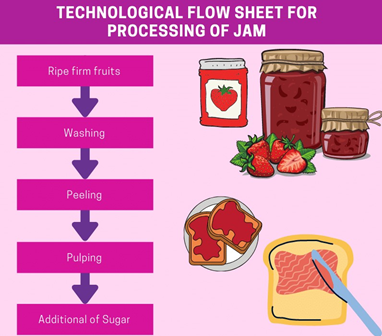
Mixed Fruit Jam Production
In-Brief
- Jam is one of the worldwide used food, it has a part in every culture, and its flavours can represent their tradition.
- Studies show that First-ever evidence of jam being used as a portion of food from the 1st century Ad. The flavours seem different based on the raw materials used but the process of making it is almost similar.
- Food research lab helps you to know the production of mixed fruit jam for the food product development industries and food development companies.
Introduction
Jam is made up of fruit juices, fruit pulp, fruit juice concentrate or dry fruit. These pieces of fruit or the pulp or juice are boiled along with sweeteners, namely sugar, dextrose, invert sugar or liquid glucose to a suitable concentration. It can be prepared by adding a combination of fruit pieces together or also with one specific fruit. An entirely made jam will contain favours of the fruit(s) used for manufacturing and will be free from any additional burnt or undesirable flavour and crystallized sugar.
Jam is prepared for personal use at home and also for commercial purpose. Commercially prepared jam is manufactured in food industry companies by two methods. One is “Pan method ” that gives traditional taste, and the other one is by using vacuum machines for production in large quantities. The food industry companies and the recipe development should come up with a mouth-watering fruit jam.
Procedure for making mixed fruit jam:
1. Inspection
The first step of jam production is the selection of ripe fruits. These fruits are handpicked and categorized based on their colour, smell and appearance. Rotten or damaged fruits are removed.
2. Washing
selected fruits are now washed with water containing 200 ppm of chlorine. Properties like pH and temperature are maintained. Water is not forced instead of Dump and spray washers are used in industries to prevent fruits from getting damaged.
3. Peeling
For small quantity manufacturing to the food manufacturers of the UK, fruits are peeled using hands. And for large manufacturing, a machine with blades are used for the purpose. Some fruits need not be peeled in such cased pulping is done.
4. Pulping
Seeds and core part are removed by pulping. There are various kind of machines available in the market for different fruits. These machines contain blades that can be adjusted to the needed size and quantity of material to be pulped.

5. Addition of sugar
Sugar and pectin are added to the prepared fruit pulp in the required quantity using the suggestion of recipe development services. Water can be added to lower the concentration. A network is formed as sugar is added because it frees up the pectin chains and binds the water molecules together.
Harder jam is made by adding more pectin and sticky jam is made by adding more sugar says the recipe development consultants.
6. Boiling
One of the most critical steps in jam making is boiling, which has to be done with more patience.The prepared mixture kept on the flame. After a few mins, the sugar starts to dissolve the room is filled with a fruity smell and a network like pectin.
During this process, A foamy scum can be seen forming over the layer that can be skimmed with a spoon while the mixture is cooling or butter can be added at this point to break the surface tension.
7. Addition of citric acid
The required amount of citric acid is added while boiling. To ensure the proper setting of jam temperature of heating is maintained at 105 C or 68-70%TSS. To check the background of the jam sheet test is conducted.
Sheet test is conducted by taking a small portion of jam and cooked a little then it is allowed to drop from the spoon if the jam drops or flakes the jam is prepared perfectly if not the jam is boiled for some more time.
8. Filling into bottles
Bottles are sterilized before the hot jam is poured into it, cooling of these hot bottles is done by putting it into the water bath. Paraffin wax or other waxes are used for waxing after which metal caps are vacuum capped to the bottle.
9. Storage
Bottled jam is now ready to be stored, and these are kept in a cool and dry place and protected from direct sunlight. Bottled jams have a shelf life of at least 12 months. The food development industry must check this properly.

Conclusion
There are thousands and thousands of jam available in the market which can make even your boring morning breakfast delicious. A proper blend of sugar and suitable fruits will make the jam taste divine. The new product development in food industries should make mixed fruit jam using fresh fruits, with an emphasis on reducing the sugar content, for consumers are becoming health conscious and are keen on reducing sugar intake. In addition, processing parameters can be optimised to retain its sensory properties.
References
- Awolu, O. O., Okedele, G. O., Ojewumi, M. E., &Oseyemi, F. G. (2018). Functional jam production from blends of banana, pineapple and watermelon pulp. International Journal of Food Science and Biotechnology, 3(1), 7-14.
- Garcı́a-Martı́nez, E., Ruiz-Diaz, G., Martı́nez-Monzó, J., Camacho, M. M., Martı́nez-Navarrete, N., &Chiralt, A. (2002). Jam manufacture with osmodehydrated fruit. Food Research International, 35(2-3), 301-306.
- Shakir, I., Durrani, Y., Hussain, I., Qazi, I. M., & Zeb, A. (2008). Physicochemical analysis of apple and pear mixed fruit jam prepared from varieties grown in Azad Jammu and Kashmir. Pak J Nutrition, 7(1), 177-180.





